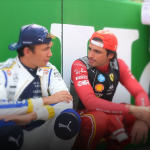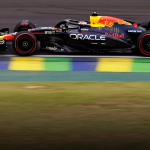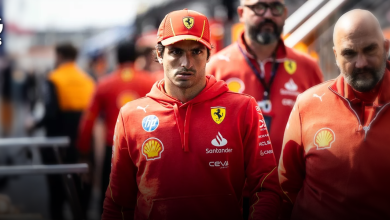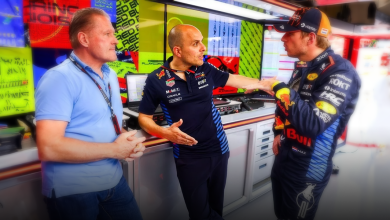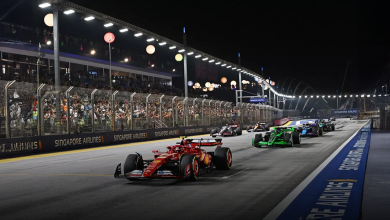F1 TECH | Tyre composition and performance factors

Formula 1 tyres have evolved over the years due to changing regulations and rules. The transition from grooved tyres to the 18-inch slick tyres used today is one of the most striking examples of this transformation.
The basic material of tires is usually composed of elastomer compounds. These compounds are obtained by combining several components with different functions. We can imagine the elastomer structure as a spaghetti network. In order for this structure to gain its elastic properties, countless chemical chains are brought together with cross-links. Sulfur element is usually used in the formation of these cross-links. However, in order for these properties to be realized, the elastomer must go through a process called vulcanization.
The composition of an F1 tyre is made up of a number of specific substances. The tread structure is a mixture of synthetic rubbers such as SBR (Styrene-Butadiene Rubber) and natural rubber. Zinc oxide (ZnO) and sulfur are added to initiate the vulcanization process of this mixture and accelerate the cross-linking mechanism. Carbon black and silica are also used to increase the durability and mechanical properties of the compound.
Materials such as Kevlar and carbon fiber are also used to strengthen the hardness properties of F1 tires. In addition, antioxidants and various chemicals are added to the mixture to prevent deterioration that may be caused by environmental factors.
The balanced combination of these materials allows F1 tires to provide both durability and high performance, allowing them to offer superior grip on the track.
WHAT KIND OF MENU DOES PIRELLI OFFER TO TEAMS?
Formula 1 tire supplier Pirelli offers its high-performance and superior grip P-Zero tires to teams, while providing 6 main slick tires and 2 wet surface tires (transitional and wet surface) options each race weekend.
Slick tires are classified from C0 to C5 according to their softness levels. C5 is the softest and fastest compound, but has the disadvantage of rapid wear, while C0 stands out as the hardest and most durable option, but offers lower performance. The optimum operating temperatures of tires vary between 90-110°C depending on the compound.
During race weekends, teams are offered 3 main tyre options, chosen from 6 compounds, and these tyres are categorised as ‘soft, medium and hard’.
Wet and transition tyres have a grooved structure to ensure water drainage. This design allows vehicles to avoid aquaplaning at high speeds. Blue logo wet tyres can drain 85 litres of water per second at 300 km/h, while green logo transition tyres have the capacity to drain 30-35 litres of water per second at the same speed.
On a rain-free race weekend, each driver has a limited stock of 13 sets of tires. These 13 sets of tires are used in a specific distribution according to the compounds. Drivers are allowed to use 2 sets of hard compound, 3 sets of medium compound and 8 sets of soft compound tires throughout the weekend. This distribution stands out as an important factor affecting the strategic decisions of the teams.
THE IMPORTANCE OF TIRES IN STRATEGY
While the elements that govern tyre strategy are mainly oriented towards the drivers’ actions, the tyre plan to be implemented during the weekend is largely the team’s decision. Teams usually use the first day of practice to try different tyre compounds and determine the most appropriate strategy for the race.
Decisions for the weekend are based on a combination of data provided by Pirelli, tyre degradation observed in driving simulations, the nature of the track and race day weather forecasts.
On the other hand, it is very important to avoid unnecessary tyre wear during practice, because having fresh soft tyres in qualifying gives a big advantage in terms of performance. In the race, keeping fresh tyres can be a critical advantage, depending on team strategy.
For example, teams must ensure that they have enough fresh tyres to cover the need for frequent tyre changes, as hot weather conditions can cause tyre wear to occur more quickly. In addition, Formula 1 rules require each team to make at least one pitstop per race. Making fewer pitstops increases the chance of winning a race. Therefore, planning pitstop timing correctly is of great strategic importance.
Track layout also has a direct impact on tyre strategy. If a track is difficult to overtake on and the likelihood of getting stuck behind another car is high, teams may consider making more pitstops. This strategy is an effective way to ensure drivers are running on a clean track rather than wasting time behind a slower competitor.
The compatibility of the vehicle with the tires is another important factor. Understanding how a vehicle behaves on the tires and anticipating this in the race is critical to adjusting the strategy and race pace correctly. A vehicle that minimizes tire wear can create different opportunities during the race and increase performance.
As a result, Pirelli’s Formula 1 tyres are extremely complex and high-level products that combine engineering, chemistry and material science. Teams need detailed knowledge and the right strategy to get the most out of these tyres.








